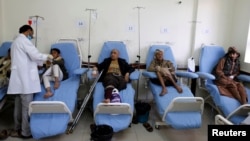New cancer cases are projected to rise by 77% to more than 35 million in 2050 from an estimated 20 million new cases and 9.7 million deaths in 2022, according to new data released Thursday by the World Health Organization’s cancer agency, the International Agency for Research on Cancer (IARC).
The report, which is being issued ahead of World Cancer Day February 4, projects the greatest relative increases in cancer cases will occur in lower human development index (HDI) settings. That is a reference to a tool developed by the United Nations to measure a country’s level of social and economic development.
“We expect the global population of the world to rise from eight billion currently in 2022 to almost 10 billion, 9.7 billion, by 2050 and this will have a large impact on the number of new cancer cases,” said Freddie Bray, head of the cancer surveillance branch at IARC.
“You will see a 142% increase in cancer cases predicted by 2050 in low HDI countries. These are the countries that have fewer resources to manage the cancer burden,” he said, noting that cancer deaths likewise are projected to almost double in 2050.
The report cites tobacco, alcohol, and obesity as key factors behind the increasing global incidence of cancer, with air pollution a major environmental risk factor.
New estimates show lung cancer to be the most commonly occurring cancer worldwide with 2.5 million new cases in 2022. Female breast cancer ranked a close second, followed by colorectal, prostate, and stomach cancers.
The report said breast cancer was the most diagnosed and leading cause of death for women. For men it was lung cancer.
Bray observed that, “One in five men and one in five women will develop cancer in a lifetime and around one in nine men and one in 12 women will develop and die from the disease.”
The global estimates reveal striking inequities in the cancer burden, with people in poorer, less developed countries most at risk. Isabelle Soerjomataram, deputy head of the cancer surveillance branch at IARC, says that is particularly true for breast cancer.
“Women in lower HDI countries are 50% less likely to be diagnosed with breast cancer than women in high HDI countries, yet they are at a much higher risk of dying of the disease due to late diagnosis and inadequate access to quality treatment,” she said.
A World Health Organization survey of 115 countries shows most countries do not adequately finance cancer and palliative care services, as part of universal health coverage, a situation that disproportionately affects underserved, poorer populations.
“Health care expenditure, particularly in cancer is increasing,” said Andre Ilbawi, WHO technical lead on cancer. “New technologies, population aging, and more people accessing more complex services are straining health budgets. Out of pocket payment in cancer is high and often push families into poverty,”
When people diagnosed with cancer are told they must pay out of pocket, Ilbawi said they are less likely to seek help, receive treatment and complete their care.
“That makes cancer more deadly and more expensive for economies, particularly as the burden of cancer increases,” he said, noting that governments can break this cycle by investing in cancer services.
“Cancer does not need to be expensive and should not be a death sentence,” he said.
“This is not the time to turn away. This is the time to double down and make those investments in cancer prevention and control or else we will be dealing with inequities that are even worse than what we see today.”
Soerjomataram also stressed the urgency of investing in prevention to address the growing global cancer burden and global inequities in cancer outcomes.
“Investing in prevention is becoming very key because we cannot treat our way out of cancer,” she said. “Treatment and providing access to care is important in preventing cancer so that no one is suffering from it.”








